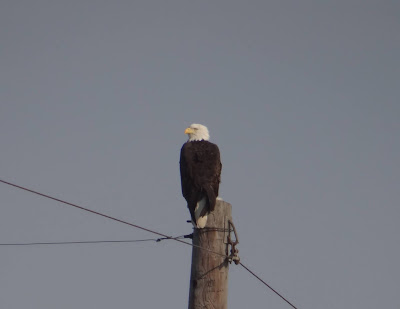Birders are a weird bunch. We got to places and do things that a "normal" person would never, like waking up before dawn in the winter, driving across the state and back in one day, and going to some wacky locations like a dump or water treatment plant in the name of seeing birds. In the past I have gone to a dump to (unsuccessfully) look for Tamaulipas Crows, and I've been to a few water treatment plants in my brief birding career. In fact, these plants can be amazing birding locations. The tanks can hold a variety of shorebirds and ducks, and the property usually sits on some forest as well.
Southside Wastewater Treatment Plant is one of the best, if not the best place to bird in Dallas. It's a massive property that has a wide variety of habitats, which is evident by the whopping 261 species that have been reported there. Rare birds are seemingly reported weekly, and it is one of the few places in Dallas county where you can see Wood Stork, Prothonotary Warbler, Bald Eagle, and Crested Caracara. There is one con, and that is access. You can't access it unless you gain permission, but that list is usually updated quarterly.
 |
| No identification necessary |
I finally got access starting September 1, but Washington and a major exam for work kept me indoors until last Saturday. Even then, I had to officiate a wedding that afternoon so I couldn't stay long. Matt Duross gave me a tour of the property, which he said is 15 square miles. I had a good omen at the beginning with Pileated Woodpeckers flying overhead, a county bird for me. We started out on some tanks just by the administration building that were full of shorebirds. Peeps were everywhere and we got excellent side by side looks at Greater and Lesser Yellowlegs. A Red-necked Phalarope had been seen here for a week, which would have been a Texas bird, but it was not to be found. Oh well, I saw them in Washington and at the clip rare birds show up here I'll likely get another crack at one next spring.
We continued to a field that was full of White and White-faced Ibises, more than I've ever seen. As we drove on we got excellent looks at Northern Harrier and a few Red-tailed Hawks, but our biggest prize was a pair of Crested Caracaras, possibly the only place in Dallas to see them. I have not seen them in a while, and they looked stunning in the clear sky.
 |
| Crested Caracara |
We went and looked at some empty tanks that were full of swallows, which are extremely hard to ID when they are flying in swarms. These tanks were just on the edge of the property, which borders a hunting and fishing club that offers no access. Matt said he has seen Wood Storks, very scare in Dallas County, flying over in season. I wish I had been here a few weeks prior! We drove along the levee past the nesting spot for Prothonotary Warblers on our way to the main event of the morning.
Bald Eagles don't need an introduction. But a lot of people have never seen an eagle, Bald or Golden, and underestimate their size. I've seen them up close in Maine and I've watching them soar along the Kenai River in Alaska during the salmon run and it is absolutely breathtaking. Most recently I saw one at Cullinan Park in Sugar Land as a speck in the sky. Seeing one is supposed to be a special occasion for me. But to see one in Dallas was something I thought to be very rare. I was wrong. There is a nest at Southside, and they are almost always there. You can also see them at John Bunker Sands, but to my knowledge those are the only 2 places one can expect to find them.
 |
| Anhinga |
We ended up seeing not one, but two Bald Eagles sitting on power lines that allowed for extended views. We also had an Anhinga on the pond when we stopped to look at them, another county bird. We didn't spend a ton of time because my introductory tour was still not over. Our last stop was a massive pond in the center of the property. There were tons of pelicans and ducks, including Ring-necked, a county bird for me. We had a curious family of Black-bellied Whistling-Ducks with ducklings, which seems to be super late in the year for them. Matt got eyes on a Bank Swallow, which is a fantastic find. He pointed it out to me just in time to get a good look at it, and then a Tree Swallow flew into view. I was beyond pumped, as Bank Swallow is a Texas bird for me. The last big find as we left was an American Avocet, a county bird.
 |
| Ring-necked Ducks and American Coots |
I saw all of the plant, but didn't have time to explore it in depth. And yet I still saw 47 species, which is probably double what I was expecting. It'll only get better as migration progresses, and I can't wait to get back when I have more time and don't have to rush home to officiate a wedding!








